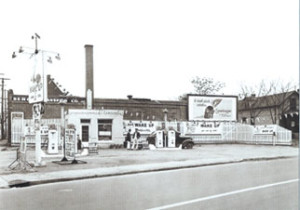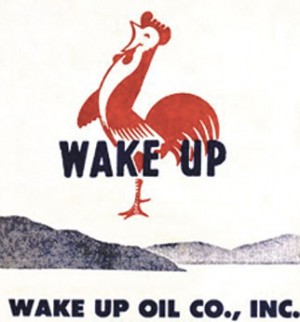Late last month there were news reports of a “gas war” between two south side Indianapolis stations, which reminded me of the “gas wars” of the late 1950s and early 1960s. In those days of black and white television and “duck and cover,” a gallon of fuel was 21.9ȼ which when adjusted for inflation is around $1.79 in today’s money; the price per gallon in the current “war.” Actually, today’s “gas war” with a reported low of $1.49 per gallon beat out a 1961 low of 18.9ȼ (2016: $1.54).
While today’s “gas war” is an isolated event, the earlier price slashing competition among filling stations was “‘a squeeze play on the independent stations’ by the major oil companies.” One of those independent oil companies with local stations was Indianapolis-based Wake Up Oil Co, and the motorist could always find inexpensive gas at the “sign of the big red rooster.”
Wake Up Oil appeared on the Indianapolis scene on the eve of World War II, around the same time that the Rock Island Refinery was built on the far north side of Marion County. For more than half a century, Indianapolis consumers benefited from this locally owned refinery distributing its products through the independent Wake Up stations and the refinery’s outlets — Golden Imperial, United Oil Service, and Crystal Flash. For teens cruising on a Friday and Saturday night with their pooled change on the dashboard, the pumps at these stations helped make for an evening of fun with a little left over for a burger and fries.
The antecedents of Wake Up Oil began in 1923 with the founding of J. A. Hogshire Oil Co. by Indianapolis entrepreneur James Allen Hogshire who was one of the original members of the Independent Oil Men of America. A decade later, the company opened a filling station at 126 W. 16th St, and in 1938 articles of incorporation were filed establishing Wake Up Oil Co. 
Eventually, Wake Up filling stations could be found on all sides of Indianapolis, including in Irvington at the southeast corner of East Washington St. and Butler Ave., and in most central Indiana cities and towns. With gas stations along U. S. 40 — the National Road — from Richmond through Greenfield and Brazil to Terre Haute; along U. S. 421 from Greensburg through Shelbyville to Frankfort; and along U.S. 31 from Columbus through Franklin and Kokomo to Rochester, Wake-Up Oil served motorists traveling the Crossroads of America.
Unlike the sleek “big oil” mini-marts with a dozen pumps dispensing that indispensable liquid craved by today’s motorists — I mean gasoline not a score of flavored coffees — the Wake Up gas station like most of its contemporaries was solid, but very simple; three pumps and a large glass windowed one-story brick or stone office cubicle providing space for the inventory of motor oil, engine belts, windshield wipers, road maps, and a mishmash of other items a motorist might need. The attendant’s desk, usually with papers scattered across the top, and a metal folding chair or two were the only furnishings. The room, accented with grease smudges here and there, carried the aromatic scent of petroleum. Over time, the simple Wake Up station, like other filling stations, evolved with the addition of an enclosed single or two bay garage featuring a hydraulic lift. The service station was born! A motorist could get his engine oil changed, a grease job, tire repair, and minor engine maintenance.
What became known as “America’s love affair with the car” got into high gear following the end of World War II. Gas stations began popping up on almost every corner in cities and at dusty crossroads along U.S. marked highways, and motorists could gas up with multiple choices of regular or “high test.” Competing filling stations began to offer promotional items to attract customers. Wake Up, supplying the motorist with “Wake Up 99 Ethyl Plus 10” and “Wake Up Premium Full Power,” gave the motorist an 11 oz. tumbler “attractively decorated with Red Roosters” for a six gallon purchase. Later Wake Up gave a “large size bag of 48 delicious Mother’s Chocolate Chip Cookies” with a purchase of gas or “99 H-D Motor Oil.” Wake Up also met the challenge of the trading stamp craze with its own brand — Rooster Stamps.
Wake Up Oil Co was a Hoosier firm selling Hoosier products, but like many other Indiana companies, the 1980s brought change. In March 1989 Marathon Oil Co. purchased the Rock Island Refinery and received a 50 percent interest in Wake-Up Oil. Four years later the refinery closed because of the expense to bring the facility in compliance with new pollution standards, and when Wake-Up merged with Emro Marketing Co, a subsidiary of Marathon, the stalwart Hoosier brand disappeared. With the beginning of the new century, many former Wake Up gas stations had become Speedway gas stations. Other former Wake Up sites were sold for commercial automotive repair garages; a few stand vacant.
Yes, there was a time not so long ago in Central Indiana when a service station meant more than a fill up and a latte. Wake Up Oil, at the sign of the “Big Red Rooster” was a true Hoosier gas station with friendly service.
-
Other News This Week
- ArtSpoken Features Works From Incarcerated Individuals
- Indiana Landmarks Hosts Woodruff Place Tour May 9
- The Answers are in the Almanac
- Health Dept. Relocating Some Clinics to New Eskenazi Campus
- Birds On The Lawn
- The Ghost of I.U.’s Lambda Chi Alpha
- This Week’s Issue: April 19-25
- “Acts of Faith” Exhibit at the Eiteljorg Opens April 20
- “Little Shop of Horrors” at the IRT
- Free Mammograms Available at Certain Francisan Health Locations
Search Site for Articles



